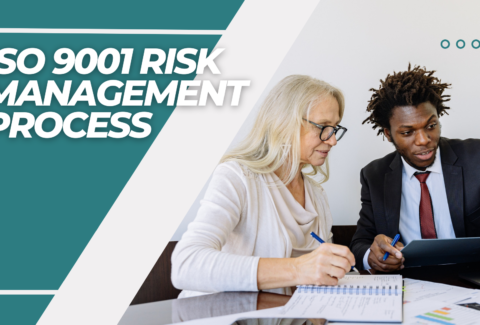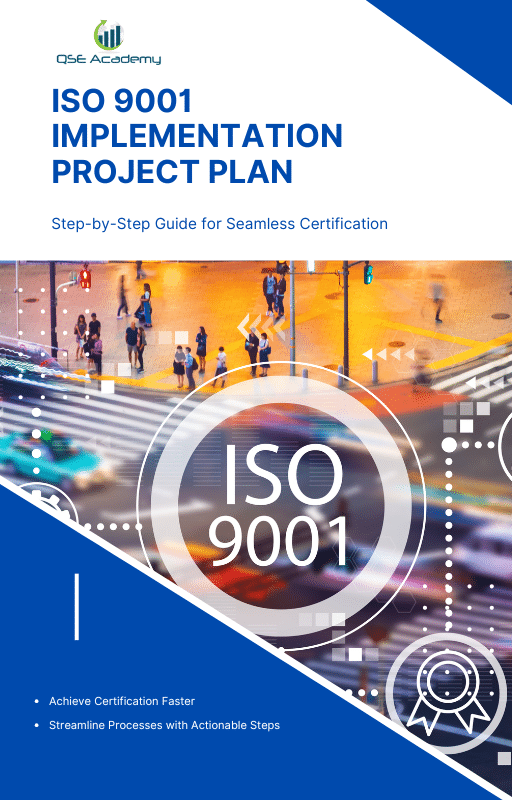How to Achieve ISO 9001 Certification for Your Business?
How to Achieve ISO 9001 Certification for Your Business?
If you’ve been thinking about ways to boost your business’s credibility, streamline operations, and impress your customers, you’ve probably come across ISO 9001 certification. It’s the gold standard when it comes to quality management, and achieving ISO 9001 certification can be a game-changer for your business. But where do you start? And how do you make sure you’re on the right path?
Achieving ISO 9001 certification might seem like a complex process, but it’s completely manageable with the right approach. From understanding the standard’s requirements to implementing a quality management system (QMS) that works for your business, each step is designed to help you improve and grow.
In this article, we’ll walk you through everything you need to know about how to achieve ISO 9001 certification, breaking it down into simple, actionable steps. Whether you’re a small business owner or part of a large organization, this guide will help you navigate the process with confidence and set your business up for long-term success. Let’s dive in!
What Is ISO 9001 Certification and Why Is It Important?
Before we dive into how to achieve ISO 9001 certification, let’s first take a moment to understand what it actually means and why it’s such a valuable achievement for businesses.
Understanding ISO 9001 Certification
ISO 9001 is an internationally recognized standard for quality management systems (QMS). Think of it as a framework that helps businesses ensure they consistently deliver high-quality products or services that meet customer expectations. Achieving ISO 9001 certification means your business has been independently audited and proven to meet these standards.
But ISO 9001 certification isn’t just about having good processes in place—it’s also about creating a culture of continual improvement. It pushes you to think critically about your operations, identify areas for enhancement, and keep evolving to stay competitive.
Why Is Achieving ISO 9001 Certification Important?
Now, let’s talk about why you should aim to achieve ISO 9001 certification. The benefits go far beyond the certificate itself—it’s a powerful tool that can transform your business in several ways:
- Build Trust with Customers
When your business is ISO 9001 certified, it sends a clear message to your customers: “We prioritize quality, and we’re committed to meeting your needs.” That kind of trust can make a huge difference in attracting and retaining clients. - Streamline Your Operations
Achieving ISO 9001 certification requires you to document and optimize your processes, which often reveals inefficiencies you didn’t even know were there. The result? A smoother, more efficient operation that saves you time and money. - Unlock New Business Opportunities
Many organizations, especially in industries like manufacturing, healthcare, and construction, require their partners or suppliers to be ISO 9001 certified. Without it, you might miss out on big contracts or partnerships. - Stay Ahead of the Competition
ISO 9001 certification sets you apart from competitors who haven’t made the same commitment to quality. It’s a badge of honor that shows you’re serious about delivering the best.
ISO 9001: More Than a Certification
Achieving ISO 9001 certification is more than just ticking boxes—it’s about transforming your business for the better. It’s about aligning your operations with global best practices, improving customer satisfaction, and driving continual improvement.
Now that we’ve covered what ISO 9001 certification is and why it’s so important, let’s move on to the steps you need to take to achieve ISO 9001 certification for your business. Ready? Let’s get started!
Steps to Achieve ISO 9001 Certification
So, you’ve decided to pursue ISO 9001 certification for your business—congratulations! It’s a fantastic step toward improving quality, building trust, and standing out in your industry. But how exactly do you achieve ISO 9001 certification? Don’t worry—I’ll walk you through the process step by step.
Step 1: Understand the ISO 9001 Standard
The first step in achieving ISO 9001 certification is understanding what the standard is all about. ISO 9001:2015 is the latest version, and it focuses on key principles like customer focus, leadership, risk-based thinking, and continual improvement.
To start, purchase a copy of the ISO 9001:2015 standard from the official ISO website or a trusted reseller. Take your time to study the requirements and how they apply to your business. If the language seems a bit technical, don’t worry—there are plenty of guides and training programs available to help you break it down.
Step 2: Conduct a Gap Analysis
Once you’re familiar with the standard, it’s time to evaluate where your business stands. A gap analysis is essentially a comparison of your current processes to the ISO 9001 requirements.
Ask yourself:
- Are your processes clearly documented?
- Do you have a system in place to monitor and improve quality?
- Are roles and responsibilities well-defined across your team?
This step helps you identify areas where you’re already meeting the standard and where improvements are needed. Knowing this upfront will save you time and resources as you work toward achieving ISO 9001 certification.
Step 3: Develop and Implement a Quality Management System (QMS)
Your QMS is the heart of ISO 9001 certification. It’s a set of policies, procedures, and processes designed to help your business consistently meet customer and regulatory requirements.
Here’s how to get started:
- Document your processes, including how you handle customer feedback, manage risks, and measure performance.
- Focus on aligning your operations with the ISO 9001 principles, like customer satisfaction and continual improvement.
- Make sure your QMS is tailored to your business—there’s no one-size-fits-all approach.
Remember, the goal isn’t just to pass an audit but to create a system that genuinely improves your business.
Step 4: Train Your Team
Achieving ISO 9001 certification is a team effort, so it’s crucial to get everyone on board. Provide training to ensure your employees understand the standard and their role in meeting its requirements.
You can host workshops, create internal guides, or bring in an ISO consultant to explain the process. When your team is engaged and informed, implementing the QMS will be much smoother.
Step 5: Perform Internal Audits
Before scheduling your certification audit, it’s a good idea to conduct internal audits to ensure everything is in place. These audits help you identify any non-conformities or areas that need improvement.
Think of this as a practice run—it’s your chance to address any gaps and fine-tune your processes before the external audit.
Step 6: Choose a Certification Body
To achieve ISO 9001 certification, you’ll need an accredited certification body to audit your business. Look for a reputable organization that’s recognized internationally, as this ensures your certification will be respected worldwide.
When choosing a certification body, consider factors like their experience in your industry, their reputation, and their accreditation. This is a crucial step, so take your time to research and select the right partner.
Step 7: Pass the Certification Audit
The final step to achieve ISO 9001 certification is the external audit, which usually happens in two stages:
- Stage 1 Audit: The auditors review your documentation to ensure it aligns with ISO 9001 requirements.
- Stage 2 Audit: The auditors visit your business to evaluate how well your QMS is implemented and whether it’s functioning effectively.
If you pass both stages, congratulations—you’ve achieved ISO 9001 certification!
Achieving ISO 9001 certification may require effort, but the rewards are well worth it. In the next section, we’ll share some tips to help you navigate the process successfully and maintain your certification over time. Let’s keep going!
Tips for Successfully Achieving ISO 9001 Certification
Now that you know the steps to achieve ISO 9001 certification, let’s talk about how to make the process smoother and more successful. While following the steps is essential, applying these practical tips can help you avoid common pitfalls and ensure your certification journey is a positive experience.
1. Involve Leadership from the Start
One of the key principles of ISO 9001 is leadership commitment, and this starts at the top. To successfully achieve ISO 9001 certification, your organization’s leaders need to be fully on board and actively involved.
When leadership takes ownership of the process, it sets the tone for the entire organization. Leaders should communicate the importance of ISO 9001 certification, allocate resources, and provide support to ensure everyone is aligned with the goals.
Tip: Schedule regular updates with leadership to track progress and demonstrate how the certification will benefit the business.
2. Engage Your Team
Achieving ISO 9001 certification isn’t a solo effort—it requires collaboration from everyone in the organization. Engaging your team ensures that they understand the standard’s requirements and how their roles contribute to meeting them.
Hold workshops or training sessions to familiarize employees with ISO 9001 principles. Make it interactive by encouraging questions and discussions about how the changes will impact their daily tasks. When your team feels included and empowered, the process will be much smoother.
Tip: Celebrate milestones along the way, like completing your gap analysis or implementing a new process. Recognizing progress boosts morale and keeps everyone motivated.
3. Focus on Continuous Improvement
ISO 9001 isn’t just about passing an audit—it’s about creating a culture of continual improvement. To achieve ISO 9001 certification successfully, embrace the mindset that there’s always room to refine your processes and enhance quality.
Use feedback from internal audits, customer complaints, or employee suggestions to identify areas for improvement. Even after you’re certified, regular reviews and updates to your Quality Management System (QMS) will keep your business competitive and efficient.
Tip: Establish a regular schedule for reviewing and updating your processes to stay aligned with ISO 9001 principles.
4. Document Everything Clearly
One of the most common challenges in achieving ISO 9001 certification is documentation. Your QMS must include clear policies, procedures, and records that demonstrate how your business meets the standard’s requirements.
However, it’s important not to overcomplicate things. Your documentation should be detailed enough to show compliance but simple enough for your team to understand and follow.
Tip: Use templates or examples from trusted ISO resources to create consistent, professional documentation.
5. Choose the Right Certification Body
Not all certification bodies are the same, and selecting the right one is crucial to successfully achieving ISO 9001 certification. Look for an accredited certification body with a solid reputation and experience in your industry.
Take the time to research your options and ask for recommendations if needed. Remember, the certification body you choose will be your partner in this process, so make sure they’re a good fit for your business.
Tip: Schedule an initial consultation with your chosen certification body to understand their process and what they expect during the audit.
6. Seek Expert Help if Necessary
If you’re new to ISO 9001 or feel unsure about any part of the process, consider working with a consultant. An ISO expert can guide you through the requirements, help you develop your QMS, and prepare you for the audit.
While hiring a consultant adds to your upfront costs, it can save you time and effort in the long run by ensuring you get things right the first time.
Tip: Look for consultants with proven experience in helping businesses like yours achieve ISO 9001 certification.
By following these tips, you’ll not only achieve ISO 9001 certification but also create a robust quality management system that benefits your business for years to come. In the next section, we’ll wrap things up and highlight the long-term value of achieving ISO 9001 certification. Let’s bring it all together!
Common Mistakes to Avoid When Trying to Achieve ISO 9001 Certification
While working toward ISO 9001 certification is a rewarding process, it’s not without its challenges. Knowing what to avoid can save you time, frustration, and resources. Let’s explore some common mistakes businesses make when trying to achieve ISO 9001 certification and how to steer clear of them.
1. Rushing the Process
One of the biggest mistakes businesses make is trying to rush through the certification process. Achieving ISO 9001 certification requires careful planning, implementation, and review. Skipping steps or cutting corners might seem like a shortcut, but it often leads to non-conformities during the audit.
How to Avoid It:
Take the time to properly understand the ISO 9001 requirements and ensure your quality management system (QMS) is fully aligned with them. It’s better to move slowly and get it right than to redo steps later.
2. Neglecting Employee Training
Another common pitfall is failing to properly train your team. Remember, achieving ISO 9001 certification isn’t just about having systems on paper—it’s about how those systems are implemented and followed by your team.
How to Avoid It:
Invest in training sessions to ensure employees understand their roles in the QMS. Use examples relevant to your business to make the training practical and engaging. When your team feels confident, it reflects in your audit results.
3. Overcomplicating Documentation
A well-documented QMS is critical for achieving ISO 9001 certification, but overly complex documentation can create unnecessary confusion. Some businesses feel the need to document every single detail, which can lead to a bloated system that’s difficult to manage.
How to Avoid It:
Focus on clarity and simplicity. Your documentation should provide enough detail to demonstrate compliance but remain practical for day-to-day use. Keep processes concise and easy to follow for everyone in the organization.
4. Ignoring Leadership Involvement
Leadership plays a vital role in achieving ISO 9001 certification, but some businesses treat it as a task for the quality department alone. Without leadership commitment, the process can lose direction and momentum.
How to Avoid It:
Ensure top management is actively involved in the certification journey. Leaders should provide clear goals, allocate resources, and communicate the importance of ISO 9001 certification to the entire organization.
5. Choosing the Wrong Certification Body
Not all certification bodies are created equal, and working with the wrong one can lead to wasted time and effort. An unaccredited or inexperienced certification body might not provide the credibility you need for your certification to hold weight globally.
How to Avoid It:
Research certification bodies thoroughly before making a choice. Look for accreditation from reputable organizations, check their track record, and ask for references from other businesses in your industry.
6. Focusing Solely on the Certificate
While achieving ISO 9001 certification is a significant milestone, focusing only on passing the audit can lead to missed opportunities for real improvement. ISO 9001 is more than just a certificate—it’s a framework for continuous growth.
How to Avoid It:
Use the certification process as a chance to genuinely enhance your operations. Instead of viewing the audit as a one-time event, embrace ISO 9001 as an ongoing journey toward excellence.
By avoiding these common mistakes, you’ll set yourself up for success and make your journey to achieve ISO 9001 certification much smoother. In the final section, we’ll wrap up everything you’ve learned and highlight the long-term benefits of this achievement. Let’s bring it all together!
Conclusion: How to Achieve ISO 9001 Certification for Your Business
Achieving ISO 9001 certification is a significant milestone for any business. It’s more than just a certificate—it’s a commitment to delivering quality, improving operations, and building trust with your customers. By understanding the process, involving your team, and staying focused on continuous improvement, you can turn this challenge into an opportunity for growth.
Whether you’re just starting out or are already on your way, the steps to achieve ISO 9001 certification are clear. Begin by understanding the standard and conducting a gap analysis to see where your business stands. From there, focus on creating a quality management system tailored to your needs, engaging your team, and preparing for the audit. Along the way, remember to avoid common pitfalls, like rushing the process or overcomplicating documentation.
The effort to achieve ISO 9001 certification is well worth it. It’s an investment that pays off in improved efficiency, better customer satisfaction, and new business opportunities. Plus, it positions your business as a trusted, quality-driven organization in your industry.
So, are you ready to take the first step and achieve ISO 9001 certification? With the right approach and mindset, you’ll not only earn the certificate but also create a solid foundation for long-term success. Now’s the time to make it happen!
Looking for More Resources on ISO 9001?
Looking for ISO 9001 Resources Tailored to Your Industry?
If this article helped clarify ISO 9001, take the next step with our industry-focused tools designed to simplify your certification journey:
📦 ISO 9001 Documentation Kits by Industry: Whether you’re in manufacturing, construction, consulting, or healthcare — we have complete, ready-to-use documentation tailored for your sector.
🎓 Online ISO 9001 Training: Learn how to implement ISO 9001 effectively with our easy-to-follow video lessons, real-world examples, and practical exercises.
📋 ISO 9001 Checklist: Download our step-by-step checklist to ensure your QMS meets all the 9001:2015 requirements from start to finish.
These resources are crafted to save you time, reduce stress, and help you achieve certification with confidence. Choose your industry and start now!

👋 Hi, I’m HAFSA, and for the past 12 years, I’ve been on a journey to
make ISO standards less intimidating and more approachable for everyone.
Whether it’s ISO 9001, ISO 22000, or the cosmetics-focused ISO 22716,
I’ve spent my career turning complex jargon into clear, actionable steps
that businesses can actually use. I’m not here to call myself an expert—I prefer “enthusiast” because I truly love what I do.
There’s something incredibly rewarding about helping people navigate food safety and quality management systems
in a way that feels simple, practical, and even enjoyable.
When I’m not writing about standards, you’ll probably find me playing Piano 🎹, connecting with people, or diving into my next big project💫.
I’m an engineer specialized in the food and agricultural industry
I have a Master’s in QHSE management and over 12 years of experience as a Quality Manager
I’ve helped more than 15 companies implement ISO 9001, ISO 22000, ISO 22716, GMP, and other standards
My clients include food producers, cosmetics manufacturers, laboratories, and service companies
I believe quality systems should be simple, useful, and efficient
Outside of work, I play piano and love learning something new every day
Let’s make ISO less about stress and more about success! 🙏

















